Opinion
Inside the NFT Rush: Entrepreneurs Promise NFTs Will Destroy the Gatekeepers, While Jockeying to Become the New Gatekeepers
In the second part of a series, we sum up some of the themes of NFT.NYC, and fail to get into a party.
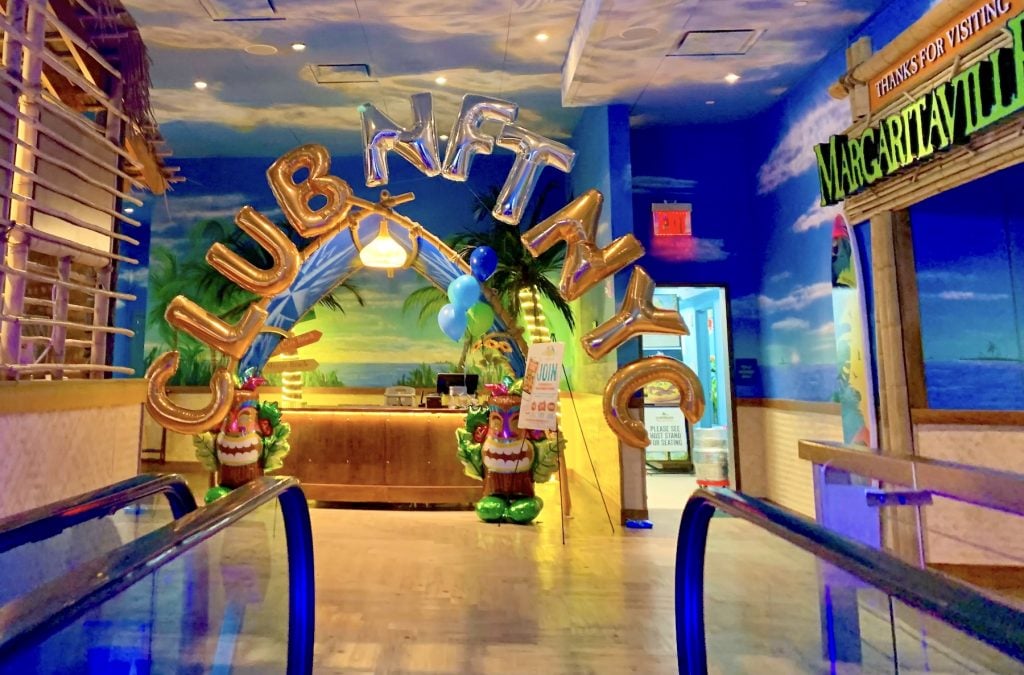
In the second part of a series, we sum up some of the themes of NFT.NYC, and fail to get into a party.

Ben Davis

This article is the second of a series about NFT.NYC and the culture surrounding NFTs. Read Part 1, Part 3, and Part 4, here.
The NFT.NYC conference officially began on Tuesday, November 2 with a takeover of a Times Square billboard by NFT art. I arrive somewhat after that early morning event, registering at “Club NFT” on 7th avenue and 40th, which is—in a choice that feels fitting—the repurposed interior of Jimmy Buffett’s Margaritaville restaurant. Of the week’s three simultaneous programs of events, I decide to focus on those in the Palladium, on 44th Street, which are all themed around art.
Down the escalators, I pass through a welter of vendors. There is a man selling, and offering samples of, “CryptoWine.” A giant banner advertises the best online marketplace to trade official Tom Felton fan art NFTs (Tom Felton being the actor who played Draco Malfoy in the Harry Potter films.)
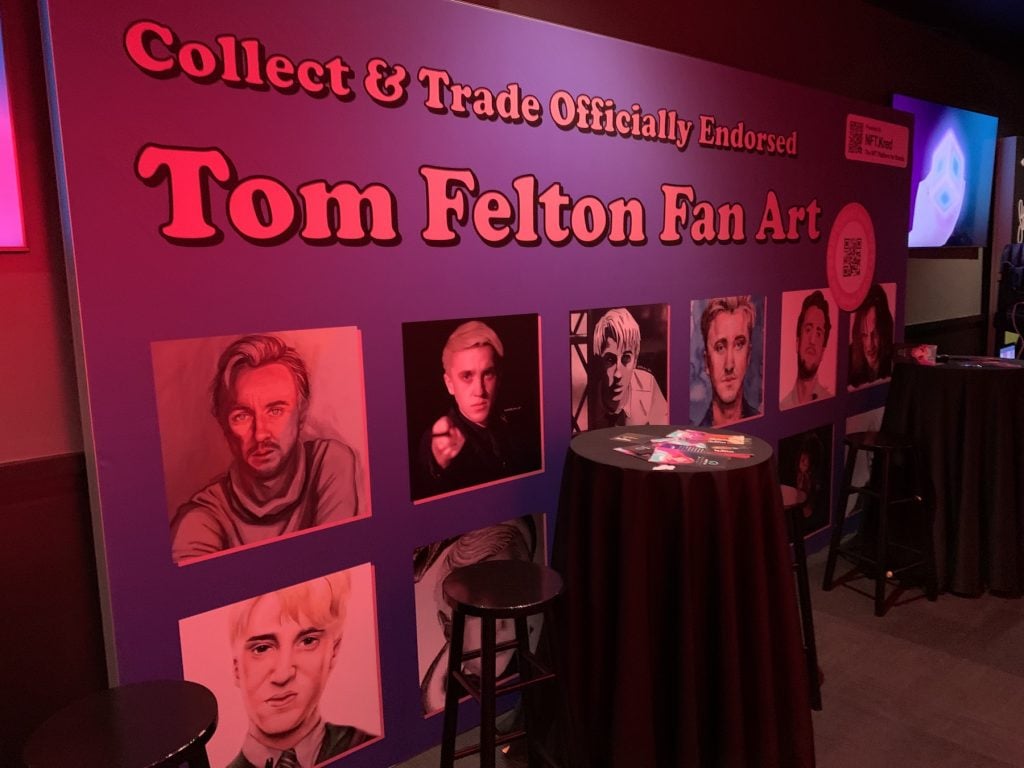
Banner advertising Tom Felton fan art at NFT.NYC. Photo by Ben Davis.
There is also a kiosk where a guy tries to reintroduce you to an NFT collection called “Fame Lady Squad,” a line of feminist avatars of cartoon women, which turned out to actually be run by three Russian men, but is now, he tells me, firmly back in control of women, and therefore a sound investment. There is also a man there trying to warn attendees of the need to “future-proof blockchain,” explaining confidently that quantum computers will make everything at NFT.NYC basically irrelevant. “They will be able to crack any code within 10 years,” he says.
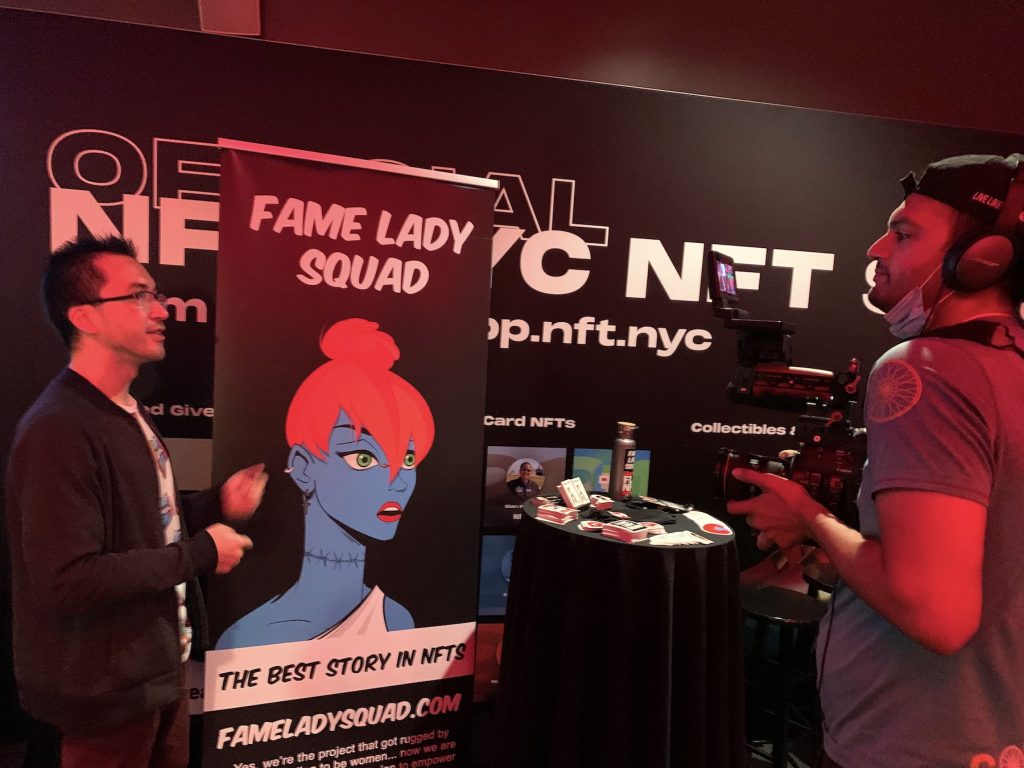
The Fame Lady Squad kiosk at NFY.NYC. Photo by Ben Davis.
Down in the half-full auditorium, past the giant interactive light exhibit sponsored by Coinbase, I quickly discover that the talks at NFT.NYC fall roughly into three categories.
One amounts to sales pitches, either touting something that solves some aspect of the dizzyingly complex series of problems associated with digital ownership, or just pitching a random associated piece of tech (at one point, what I think is an artist talk takes a turn, as the speaker tells everyone in the front row to look beneath their chair to discover the hologram-shooting pyramid device that is sponsoring her.)
The second is people who, for some reason, just try to re-articulate what an NFT is and why NFTs are good. The third category, on the other hand, is worthwhile.
A tattooed Noah Davis, who helmed the Beeple auction at Christie’s, where he is head of digital sales, comes on, and mainly seems to be there to show face before the NFT faithful. Angela Dalton, of something called Signum Growth Capital, hammers home the idea that “buying is the new liking,” a mantra she has adopted from Micah Johnson, a baseball player turned NFT star. There’s a panel on NFT use cases for charity where the baleful question “How do we gamify social impact?” is asked. (Only slightly less baleful than the shudder-inducing line I will enter to on Day Two: “Poetry is the original blockchain…”)
And then this dreary sequence is unexpectedly, and without any prior buildup, struck by lightning: Quentin Tarantino walks on stage. He is not featured in the program. Apparently this came together at the last moment.
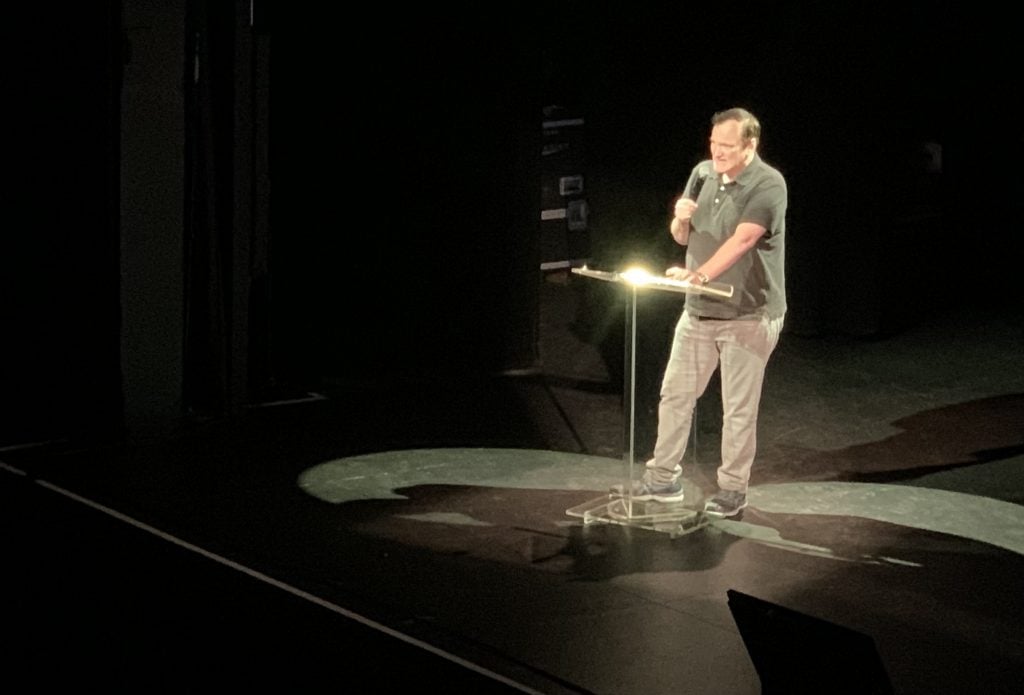
Quentin Tarantino addresses the crowd at NFT.NYC. Photo by Ben Davis.
It is not immediately clear what Tarantino is here for, as he enters into a long story about how he got funding for his first two movies. But eventually, Tarantino gets to the point that he is selling off seven “unique NFTs,” each tied to pages of a scene from his original, hand-written Pulp Fiction script. He says there’s no way in hell he’d sell the actual script or put it in a museum—but minting images of it, that he would do.
The crowd in the half-empty Palladium is palpably buoyed, even though Tarantino seems eager to get offstage and avoid a Q&A. “I did not say I would open it up to the people,” he tells the MCs, as they attempt to keep him.
Two weeks after the announcement at NFT.NYC, Miramax will announce that it’s suing Tarantino to stop the Pulp Fiction sale, saying it dilutes their own NFT efforts. (Twice during NFT Week will I will hear lawyers use the phrase “litigator’s wet dream” to refer to this new digital art world.)
Throughout the three days of talks—but particularly among the artists here—the great article of faith is that NFTs offer more than just the promise of a way to value digital art. NFTs will also fix art, enabling a new “decentralized” art world, an art world where anyone can participate in a new way, without the “gatekeeping” of snobby experts, blood-sucking galleries, and so on, where all can flourish. The touching crypto-community mantra “We’re All Gonna Make It” (WAGMI) captures this hope.
Occasionally, this promise hits perplexing evangelical highs. In a talk about digital fashion, marketer and entrepreneur Enara Nazarova—who wears large stylish glasses that have literal rose-tinted lenses—declares NFTs a “modern counterculture,” and “not just a technology, but a movement” that will take us “from hierarchies to a networked world.”
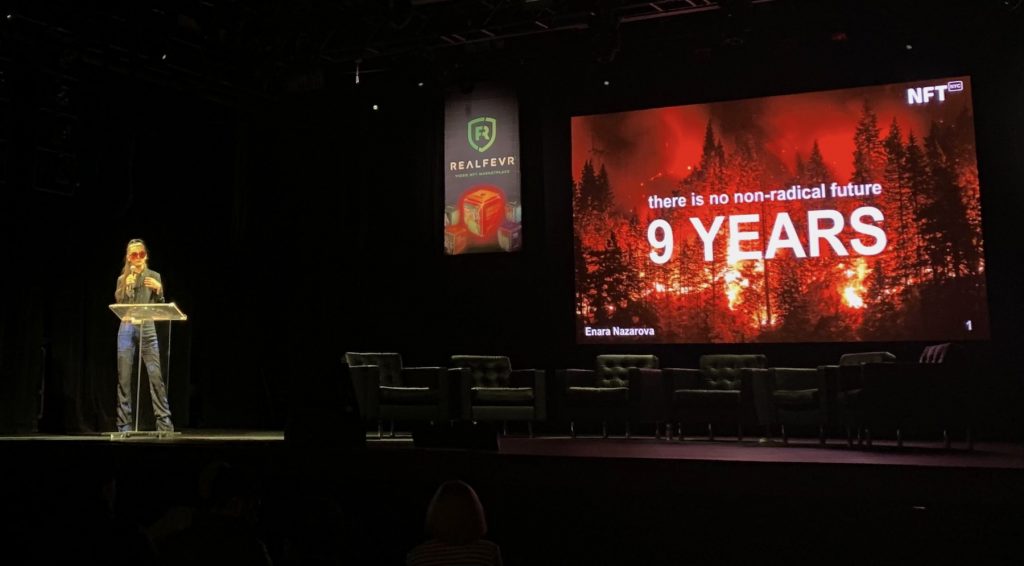
Enara Nazarova speaks at NFT.NYC. Photo by Ben Davis.
I am not surprised to hear Ayn Rand quoted throughout the conference, but I am surprised to hear Nazarova quote leftist writer Naomi Klein’s mantra, “there are no non-radical futures left”—except Nazarova doesn’t mean there’s a need for a radical new anti-capitalist project to rebuild the welfare state for a just transition in the face of climate breakdown. She’s asking us to think of the revolutionary new monetization opportunities for creatives within the metaverse.
Nazarova ends her talk by saluting NFT.NYC attendees with the words of the fictional toy spaceman Buzz Lightyear from Toy Story: “to infinity and beyond!”
All this euphoric rhetoric about the liberating potential of going from “hierarchies to networks” sounds suspiciously exactly like what has always been the libertarian, Silicon Valley, tech-will-save-the-world default product pitch, the so-called Californian Ideology (see Fred Turner’s classic From Counterculture to Cyberculture on its origins and corruption). It is being taken at face value here as a mission for NFTs exactly at a moment of reckoning for the tech industry, when the broader public has realized how the mantras of “don’t be evil” and “move fast and break things” covered up very cynical and callous commercial motives, leaving us with power concentrated among a handful of tech giants, Gilded Age levels of inequality, and a broken communications environment.
It seems obviously a case where the cure you are being sold is more of what made you sick. Even if you see positive applications for the tech—and I do—I can’t see any utility to this utopian rhetoric besides deliberately obscuring the real dangers to be navigated.
When the founder of NFT.NYC, the affable Jodee Rich, comes out on Day One to hail the startling growth of the 2021 conference, someone from the audience asks him directly about this in the Q&A: How will Web 3.0 avoid the problems of equity that have come to plague Web 2.0? He has no real convincing answer. Rich just says the technology somehow won’t do this because it can’t: A blockchain is “not really owned by anyone” and “blockchains can’t be taken over.”
Even on the evidence of NFT.NYC itself, the “death of the gatekeeper” narrative is pretty thin. Based on both butts in seats and audience engagement, interest in the artist panels is crushed by interest in representatives of the large NFT trading platforms, various venture capital funds and crypto asset managers, tech folks flogging their proprietary solutions, and influencers like Gary Vee, whose public stamp of approval can make or break a project.
You might even suspect that all the talk about the “death of the gatekeeper” is just so much hype from people bidding to be gatekeepers within this new crypto landscape.
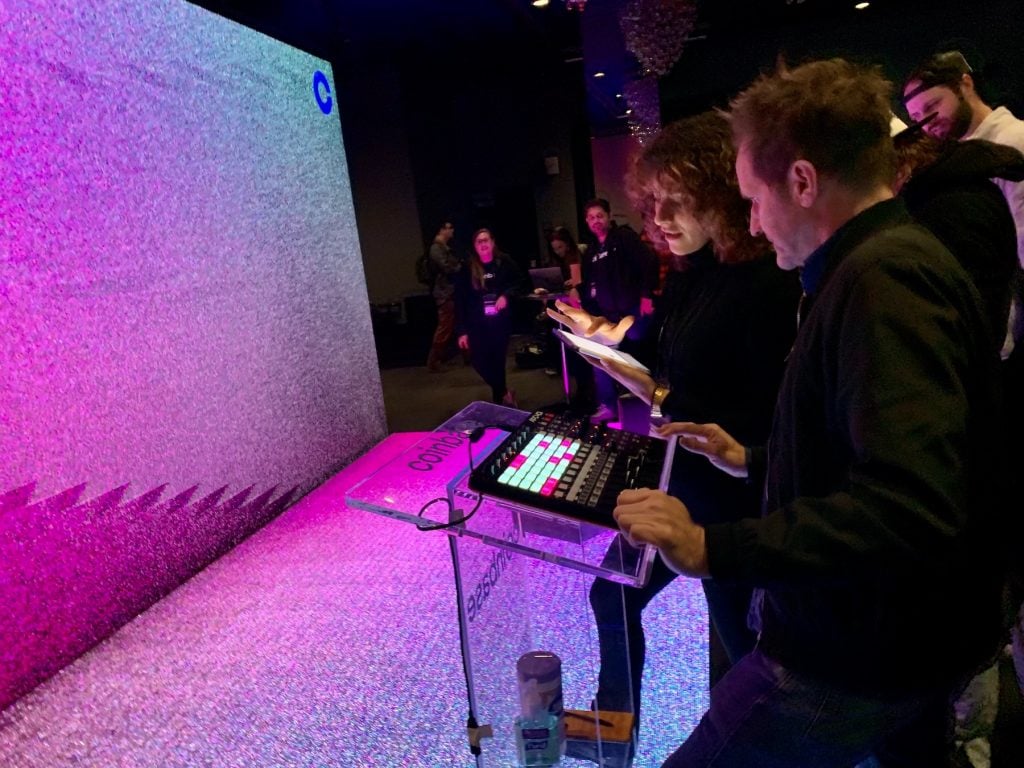
Coinbase kiosk at the NFT.NYC conference. Photo by Ben Davis.
The single most-mentioned inflection point for legitimizing the NFT scene is the $69 million sale of Beeple’s Everydays at Christie’s in March, which may prove to be the most discourse-altering art auction in history.
Twobadour (a.k.a. Anand Venkateswaran), spokesperson for Metapurse, the fund that bought the work, speaks on a panel where he reminds his audience that “crypto needs art more than art needs crypto.” He will point out that “all of this technology has been around for a while now.” The stamp of approval from the mainstream, “traditional” art institutions changed the public perception of both cryptocurrency and crypto-art in a big way.
This is, of course, the very definition of a gatekeeping function: conveying legitimacy and brokering connections.
Auction houses, as secondary marketplaces, are quintessential “middlemen.” (The average “traditional” artist has about the same view of auction houses—as citadels that they are shut out of—that the average digital artist seems to have to the “traditional” art world.) They have not, historically, shaped emerging contemporary art movements quite so intimately as Sotheby’s and Christie’s are doing now with NFTs.
So one might suspect, based on recent history, that the effect of NFT-ization has already not been to weaken “gatekeepers” in the art market, but to concentrate power in the hands of the large art corporations and further dilute the power of the already struggling lower layer of smaller galleries.
One of the more lucid things I will hear during NFT.NYC comes from Yannick Folla, co-founder of Ox Society, a Montreal-based non-profit looking to promote crypto-art in brick-and-mortal space, on a panel about NFT art galleries. We are already in a different moment, Folla asserts, then even earlier this year, when the Beeple sale sent up a flare for all the world to see. Then, there was “a lot of interest but not a lot of artists.” You could, in effect, hang your hat out and immediately be at the center of the action. Now everyone wants in.
“As we onboard the next 100,000 artists we will get back to the same issues of the traditional art world,” Folla predicts. “Not every artist can represent themselves.”
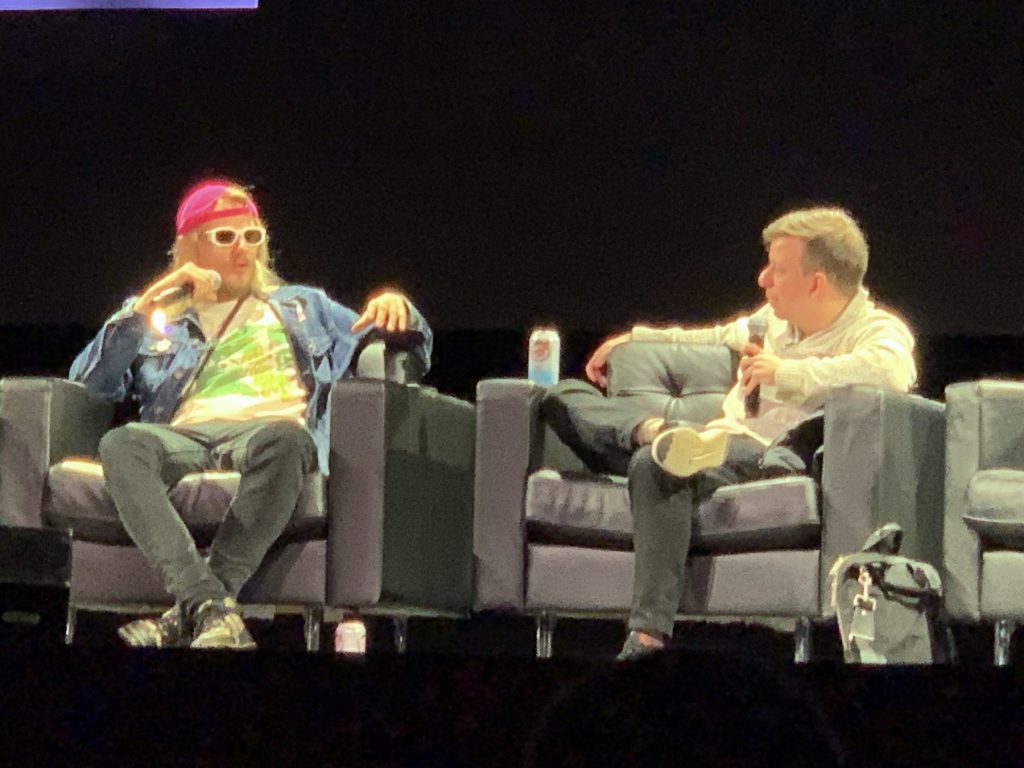
NFT Hypeman in conversation with NFT Nick on Day Two of NFT.NYC. Photo by Ben Davis.
On another panel, NFT Nick (a.k.a. Nick O’Neill), a likably candid NFT commentator who boasts ruefully about his videos where people watch him day-trade NFTs (“I’m quickly running out of money so I am looking for sponsors”), repeats Folla’s sentiment. “It’s so tough for people to get their name out there…,” O’Neill says. “There’s a flood of people coming in. It’s really hit or miss whether they can sell their art.”
His advice? “Either develop an audience with the people who collect NFTs or you are shit out of luck. In the traditional art world galleries will do that for you, but here no one is going to do that outside of influencers.”
Head abuzz with all these thoughts after Day One of NFT.NYC, I go to check out the NFT after hours circuit. I’m invited to a Hypebeast event, featuring the hip-hop artist Artz, who will speak on Day Two, where he will quote Black Panther Party founder Huey Newton about the grit needed to endure in the NFT space: “Sometimes you have to fight for Revolution without seeing the fruits of your labor.”
I get there a half hour early and there is already a long, long line. I am parked, in the dismal cold, in front of a pizza shop that itself has a large poster in the window advertising some kind of NFT-based pizza scavenger hunt.
It is a young and fun crowd and palpably ready to party—but the event is over an hour late in getting started. When the line finally begins to move, organizers are shuttling people up to the 12th floor in an elevator that holds four at a time.
In the meantime, I get to know my neighbors in party purgatory. Dylan, a long-haired, mellow 20-something is alone, coming direct from the NFT.NYC conference, like me. “I was burned investing in Mutants,” he says, ruefully. “I lost a lot of money. I’m thinking I am going to make it back in Gutter Cats.” The mention of Gutter Cats gets him into a debate with two developers from Argentina, Juan and Benjamin, about the fundamentals of the Gutter Cats community.
On the other side is a gaggle of people, many in Bored Ape swag. They are not on the NFT conference track; they are on the party track, and some are still recovering from being wasted aboard the coveted kick-off NFT party on an actual yacht.
B A Y C !!!@BoredApeYC #apefest pic.twitter.com/wuafGryTs3
— swickie (@topshotswickie) November 1, 2021
Everyone in this group has met through different intersections on the global NFT event circuit. They more or less value NFTs as passports to a scene rather than as works of art. They roll their eyes about the “sneakerhead or eBay flipper types.”
Rania, the ring leader, is a fast-talker in a white jumpsuit and Russian fur hat. After 45 minutes of interminable stand-still, she tries and fails to jump the line, appealing directly to the organizers, who are apologetic but immovable. Talk falls to her work, about which she is vague, but she seems to be some kind of NFT consultant.
The last project she worked on was a “rug-pull”—the developers took everyone’s money and walked away without delivering the advertised collectible profile pic project, or her money. “Fuckin’ scammers, right?”
It’s punishingly cold and I haven’t moved from in front of the pizza parlor. I head home to prepare for the next day.